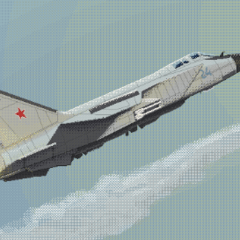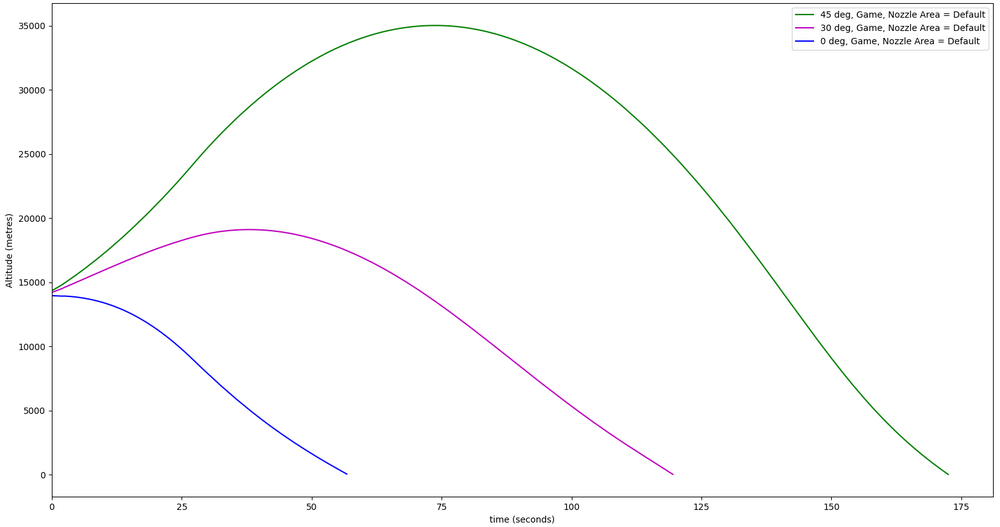-
Posts
410 -
Joined
-
Last visited
-
Days Won
1
About JNelson
- Birthday 11/22/1996
Personal Information
-
Location
England, Gloucester
Recent Profile Visitors
The recent visitors block is disabled and is not being shown to other users.
-

DCS: F-4E - Episode IV - RADAR Pt. 1 - Basics and Theory
JNelson replied to IronMike's topic in DCS: F-4 Phantom
I knew the M2K did something with RCS, but it's interesting we have converged on essentially the same solution. In the F-4E implementation the relation between RCS and the amount each side presented to the radar is not linear so as to give a shape closer to that of the general trend of RCS diagrams. There are factors for, side, top, bottom, and front and back which multiply the base RCS based on the amount of each side presented to the radar (as mentioned before not linear though). -

DCS: F-4E - Episode IV - RADAR Pt. 1 - Basics and Theory
JNelson replied to IronMike's topic in DCS: F-4 Phantom
Target orientation (how much of the nose/tail, top/bottom, or left/right are presented to the radar) will significantly alter the resulting RCS of a contact in our model. Just to clear something up, the conical scanning is simulated, so there is no "transferring the lock away", rather the antenna is pulled towards the maximum of the total signal (in the conical scan on average), including all kinds of clutter/noise (jamming, chaff, ground clutter and targets). As for chaff the problem is more complicated, currently in DCS chaff objects are very short lived, so building volumetric chaff clouds is not possible (with correct synchronization) or worth the cost at this time, we have asked ED for a more useful data-structure with regards to this which is being looked into for the future. The primary concern relating to the above is the track being disturbed by an aircraft dropping something which a huge RCS very quickly. To combat this the chaff takes some time to bloom and gradually comes up to it's full RCS (as it would IRL) as specified by DCS. -
You can hit cage on the throttle, to break the lock and go back to caged mode, you can then re-enter CAA again with the nosewheel steering button.
-

Feedback Thread F-14 Tomcat Patch July 24th 2023 + Hotfix 28/07/2023
JNelson replied to IronMike's topic in DCS: F-14A & B
Yes unfortunately a change that was a part of the overall fixes did not make it into this patch. As a result the loft will be lower, the original loft however will be restored in the future patches. -
The ALR-45, APR-36, and APR-25 are all similar family and the ALR-45 will be done for the early tomcat. The ALR-46 will be the RWR on release for the F-4E. As Cobra says we would like to do an APR-36 but no promises at this time. Sorry for any confusion.
-
No you read correctly it was mach, before I went back and changed it like a minute later. In what you post here it seems to suggest that these are hypothetical scenarios and that "Weight reductions improve the performance". The source of this powerpoint is the same study which produced "New Air-Launched Small Missile (ALSM) Flight Testbed for Hypersonic Systems" so I would be surprised if they had different findings on what the phoenix was capable of.
-
The altitude graph is in metres. The Mach 5.1 you describe comes from the simulated phoenix which has 250 lbs removed.
-
Yea it's not trivial to get the missiles to fly in a ballistic trajectory. You have to disable some stuff in the lua config like the guidance and the induced drag and lift (the latter two because the stability of the missile in the old schema which the AIM-54 uses does not appear strong enough to keep the missile on a ballistic trajectory, this doesn't actually matter because the test is conducted with a zero lift condition anyway). You can see below with those accommodations the missile follows a ballistic trajectory rather nicely (remember this is time not down range distance so the actual trajectory depends on speed).
-
Hello Florian, Thank you for your detailed research. It's worth noting that what can be seen in the game files can not always be compared with reality because it depends on how Eagle Dynamics interprets those numbers which might not always be obvious from an outside perspective. If you compare Figure 7. Launch elevation angle effects on ALSM flight performance (Mach 1.2, 45,000-ft launch conditions). From the document you attached "New Air-Launched Small Missile (ALSM) Flight Testbed for Hypersonic Systems" you will find that currently the performance of the phoenix is very close to that simulated in that paper. Please rest assured the effective overall impulse and thrust of the missile are very close to their real values for in game and they match sources and match test shots withing 5% error for things like impact velocity, loft altitude and time until impact. Finally please see the attached graph which are the same parameters as figure 7 with the NASA simulation overlayed (dashed) with the DCS results (solid).
-
Dive toss in the F-4E is similar to the CP-741 computer in the A-4, however the DMAS upgrade actually added CCIP to the Phantom. Where the dive toss is more like a CCRP mode.
-
This demonstrates what the radar roughly looks like, but it's from a simulator, also they only go into acquisition not track. Here is a video of the AN/APQ-120 with the DSCG screen, in flight.
-
Our F-4E has dive toss, this is like a pseudo CCRP mode, you have the WSO lock the main lobe clutter from the radar in the air-gnd mode (don't be fooled this is the same as boresight pretty much but the antenna doesn't move when locked and the range scale can be greater than 5 nmi) then the pilot puts the pipper on the target as accurately as possible and depresses the bomb release, this tells the computer what the slant range is and it computes the target point, then using the INS the computer figures out when to drop the bomb so it hits the target.
- 12 replies
-
- 14
-

-

-

Community A-4E-C v2.2 (October 2023)
JNelson replied to plusnine's topic in Flyable/Drivable Mods for DCS World
I was just pointing out that the licensing is rarely an issue to modules and definitely not the cause for the lack of official A-4. It's definitely less certain than the sun coming up You are certainly correct a lot of the assets from the mod are unusable due to people's involvement (and licensing of the base assets for the 3d work) a lot of work would have to be redone. The module requires a lot of work regardless. It wouldn't all go in the trash but at the end of the day the A-4 for a lot of people was a hobby project and not every hobby can be turned into a monetised product. I say that as someone who wrote 60,000 lines for the A-4 project. It's understandable that people want the opposite to be true because they really want their A-4 as an official module. It's hard to fault people for their enthusiasm for the project and wanting it to be official.









